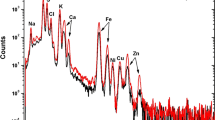Summary
The silicon content of various parts of the human brains (white matter, subcortical ganglia, stem, choroid plexus, meninges) was determined by means of emission spectrum analysis. The highest values (0.020–0.1946% of ash) were found in the meninges and choroid plexuses. The silicon content of white matter varied from 0.0022 to 0.0058% of ash, higher values being found for material from the parietal and occipital lobes than from the frontal and temporal lobes. In subcortical formations, relatively low values were found for the ganglia (0.0024–0.0044% of ash), while the neostriate system and the medulla oblongata had a somewhat higher silicon content.
Similar content being viewed by others
Literature Cited
G. A. Babenko, Trace Elements of the Brain of Humans and Animals. Candidates Thesis, Donetsk (1953).
A. O. Voinar, Biological Role of Trace Elements in Human and Animal Organisms (Moscow, 1960).
V. A. Del'va, Trudy Donetsk. med. in-ta, Vol. 11 (1958), p. 285.
V. A. Del'va, Byull. éksper. biol., No. 8 (1961), p. 59.
Author information
Authors and Affiliations
Rights and permissions
About this article
Cite this article
Del'va, V.A. Silicon content of various formations of the human brain. Bull Exp Biol Med 54, 1355–1357 (1964). https://doi.org/10.1007/BF00832801
Received:
Issue Date:
DOI: https://doi.org/10.1007/BF00832801




